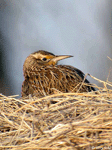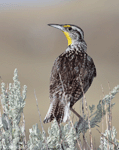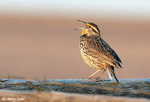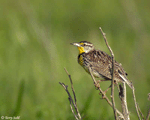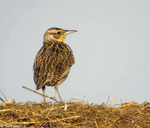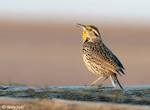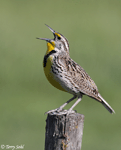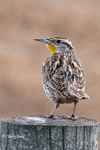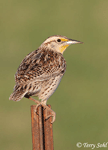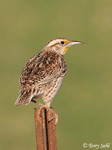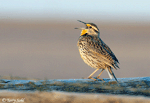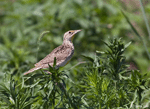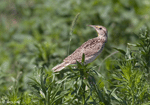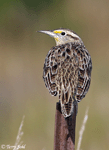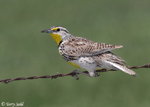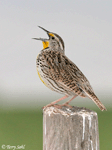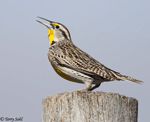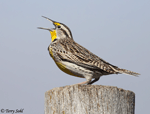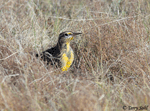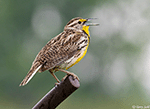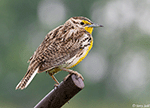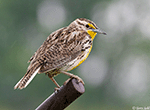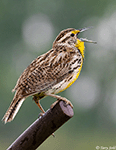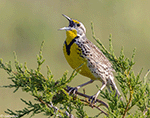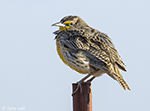| Length: 10 inches | Wingspan: 14 - 16 inches | Seasonality: Summer |
| ID Keys: Both Males and Females): Yellow breast with black "V". White outer tail feathers visible upon takeoff. Use song to differentiate from Eastern Meadowlark. | ||
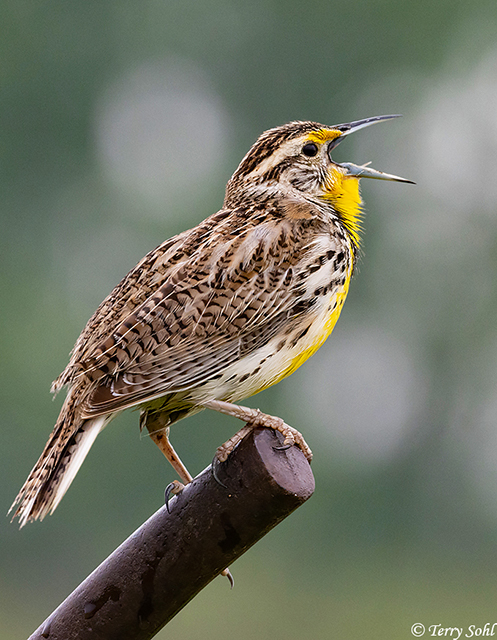 The more common of the two Meadowlark species found in the state, the other being the Eastern
Meadowlark. The songs (and normal ranges) of two species are distinctly different and provide
the best means for distinguishing between the two. The two species do
occasionally interbreed where their ranges overlap, but normally they mate with
their own species. They are a very common sight throughout the state, often found
singing on fence posts and other perches.
The more common of the two Meadowlark species found in the state, the other being the Eastern
Meadowlark. The songs (and normal ranges) of two species are distinctly different and provide
the best means for distinguishing between the two. The two species do
occasionally interbreed where their ranges overlap, but normally they mate with
their own species. They are a very common sight throughout the state, often found
singing on fence posts and other perches.
Habitat:
Grasslands, prairies, and farm fields. During the summer breeding season they are generally found in grasslands, avoiding over-grazed pastures that may lack the vegetative cover they prefer for breeding. They will also sometime use areas such as alfalfa fields during the summer months. In winter months they are found in similar habitats, including agricultural areas where waste grain from the previous harvest may be present. In all seasons, they avoid areas with substantial tree or shrub cover.
Diet:
The diet of a Western Meadowlark generally varies by season, particularly for birds found in South Dakota. During the summer breeding season they feed heavily on insects, as well as other small invertebrates including spiders. During the winter months, the diet transitions to primarily seeds and waste grain from agricultural activities.
Behavior:
Generally solitary or paired during the breeding season, but can be gregarious at other times of the year. Forages by walking along the ground, picking up insects and seeds as it goes.
Nesting:
May through July in South Dakota. The nest of a Western Meadowlark is placed on the ground, typically next to relatively dense vegetative cover like a clump of grasses. The female first prepares the site by creating a shallow depression, and then lining it with a bowl constructed primarily of grasses and the stems of herbaceous plants. They will often using overhanging vegetation to help construct a protective dome over the nest site as well. The female lays between 3 and 7 eggs, and she alone incubates them. The young hatch after about 2 weeks, and fledge from the nest about 10-12 days after hatching.
Song:
The song of a Western Meadowlark typically begins with a few sweet single notes, followed by more complex musical warbling that often descends in pitch. The call of a Western Meadowlark is a short chek.
- Click here to hear the song of a Western Meadowlark1
- Click here to hear the short call notes of a Western Meadowlark2
Migration:
Summers in the western half of the U.S. and the upper Midwest, Northern populations mouth south in the fall. In South Dakota, populations are undoubtedly far more common in the summer months, but some birds do overwinter in the state, with more birds in the southern part of South Dakota. From a personal observation in the last 20+ years...Western Meadowlarks are over-wintering at greater numbers than they used to. For example, on the Fort Pierre National Grasslands or south of there in the Presho area, 20 years ago I would occasionally see a Western Meadowlark (most typically, a single bird). Now I nearly always see Meadowlarks in winter, and sometimes in groups (particularly around Presho).
Interactive eBird map:
Click here to access an interactive eBird map of Western Meadowlark Sightings
Similar Species:
Eastern Meadowlarks are extremely similar to Western Meadowlarks in appearance. There are a few minor plumage differences that are usually extremely difficult to identify during typical field conditions. Eastern Meadowlarks generally have white or a light color behind the based of the lower mandible. On Western Meadolwarks, the area immediately behind the lower mandible is usually yellow. The head streaks on an Eastern Meadowlark are often darker than those of a Western Meadowlark. In a feature rarely identifiable in field conditions, the tail feathers on an Eastern Meadowlark generally have significantly more darker coloring along the central vein of the tail feather, while it's much less extensive on a Western Meadowlark. Despite these minor plumage difference, the safest means of differentiating between the two species is by voice (and sometimes with range as context).
South Dakota "Hotspot":
Not a difficult bird to find from spring through fall, with Western Meadowlarks found in grassland habitats across much of the state. They are also found in and around cropland areas, but not in the same numbers. In the winter months, they can still be found (in increasing numbers over the years, as noted above), mostly in the southern part of the state. In the winter months they are often found more often around cropland from the previous year, feeding on spilled grain. In the south-central part of the state, they particularly seem to be found in winter in and around fields where sunflowers or sorghum were grown the year before.
Conservation Status:
Populations may be declining in some areas, primarily due to loss of suitable habitat. However, they are still found over a very broad geographic area and are common to abundant in many areas. The IUCN considers the Western Meadowlark to be a species of "Least Concern".
Further Information:
Photo Information:
May 25th, 2020 -- Lincoln County, South Dakota -- Terry L. Sohl
Additional Photos:
Click on the image chips or text links below for additional, higher-resolution Western Meadowlark photos.
Audio File Credits:
- 1Jacob Saucier. Recorded in Valley County, Montana on June 21st, 2015. Original recording and information from xeno-canto.
- 2Bow Tyler. Recorded in Thurston County, Washington on April 17th, 2019. Original recording and information from xeno-canto.
| Click on the map below for a higher-resolution view |
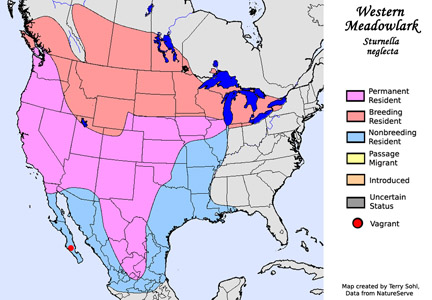 |
| South Dakota Status: Common summer breeder throughout the state. Uncommon in winter, primarily in the far southern part of South Dakota. |
Click here for additional Western Meadowlark Photos
Click for a higher-resolution version of these photos
